Week 22 - Mechanical Advantage, Speed Ratio and Gears
| Site: | MoodleHUB.ca 🍁 |
| Course: | Science 8 LearnNet |
| Book: | Week 22 - Mechanical Advantage, Speed Ratio and Gears |
| Printed by: | Guest user |
| Date: | Monday, 17 November 2025, 5:42 PM |
Description
Week 22 - Mechanical Advantage, Speed Ratio and Gears
1. Simple Machines
Lesson 4
Read pages 258 - 260 and 315 - 320
| We are all familiar with the use of machines in our daily life to make our work easier. Some of these machines are very simple in nature, but some of them are made of many parts. We will begin our study with the examination of the types of simple machines that we commonly use. Combinations of these simple machines working together in a system make more complex machines - the topic of the next lesson |  |
 |
In your study of the lever, you will have discovered that there are three types of levers - first class, second class and third class. The following video segment will help you to understand better how levers work. Pay particular attention to the position of the fulcrum, the load force and the effort force in each of the three classes of lever. |
View this website on types of levers:
http://www.enchantedlearning.com/physics/machines/Levers.shtml
Conclusions: The inclined plane, the wedge and the screw all related to each other. Generally, the inclined plane allows you to lift heavy objects using a smaller force. The down side is that you must do it over a greater distance.
The wedge is really two inclined planes together and it's main function is to split an object apart.
The screw can be thought of as an inclined plane wrapped around a cylindrical core. It functions by a rotational motion.
Pulleys
See what happens when a second pulley is added to the system.
This site allows you to work with simple pulleys and pulley systems to alter the masses in the system to see what happens. Try it out!
http://www.phy.ntnu.edu.tw/java/wheelAxle/pulley.html
© 2002 Alberta Online Consortium |
2. Complex Machines and Energy
.
Lesson 5
Read pages 269 - 276
Complex Machines and Energy
 |
You can easily see that a ramp or a pair of scissors would be a simple machine. But what about your bicycle, or a winch on a truck? These do not seem as easy to explain unless we look carefully to see how they are made up. These two complex machines are actually made from combinations of simple machines working together. |
3. MA & SR
.
Lesson 6
| In this set of lessons you are going to learn about the relationship between speed and force and how to create a machine which will give you either the speed or force advantage you want. | 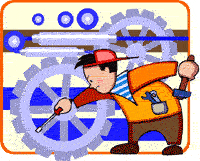 |
Part 1: Calculating Mechanical Advantage
The mechanical advantage of a machine explains how much a machine can multiply the force that goes into it. Here's how to find the mechanical advantage of a machine:
For example: If the input force is 30 N and the output force is 120 N, calculate the mechanical advantage. |
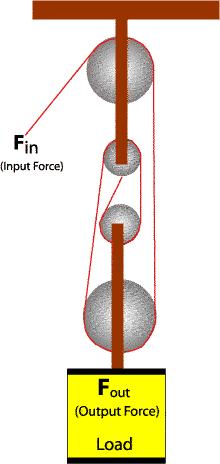 |

That means that the machine made it 4 times easier to lift than if you had to lift the load by yourself, without the machine.
The only thing that a single pulley does is change the direction. You must use 2 pulleys to cut down on the effort by half. Check out pages 280 and 281. They show 2 different sets of pulleys.
The first pulley on page 280 shows 4 pulleys and 5 cords but only has a mechanical advantage of 4.
The smaller one on page 281 only has 2 pulleys and 3 cords but only has a mechanical advantage of 2. Unless it is not a fixed pulley. Then one end of the rope is suspended so the effort is reduced by half.
An easy way to think of it as if the downward pulling rope (where the force is applied) is not being counted as part the mechanical advantage because it only changes the direction of the force.
Check out these web sites to see it in action. Once you have viewed and read the first page go to the bottom to the next page about pulleys.
http://www.technologystudent.com/gears1/pulley7.htm
In the second part of this lesson we are going to look at another way of analyzing how machines work. We are going to measure the affect a machine has on speed. Speed is the measure of the distance an object moves in a given amount of time. For example, your truck or car measures speed in kilometres per hour while the measure of the speed of light is calculated in km/s (light travels at 300 000 km/s). In our lesson we are going to determine the affect a machine has on the speed of an object. This measurement is called the speed ratio . If this sounds confusing, think of it this way. You can run at perhaps 10 km/hr, but not for very long. If you get on your bike you can travel much faster and for longer periods of time. The speed ratio (SR) is found by dividing the input distance by the output distance. Lets go back to the pulley system we used before to see how this works.
| When you want to measure the speed ratio (SR) of a machine you need to measure the input distance and the output distance. In the case of the example to the right the measured distances are: Input distance = 6 m Output distance = 1.5 m |
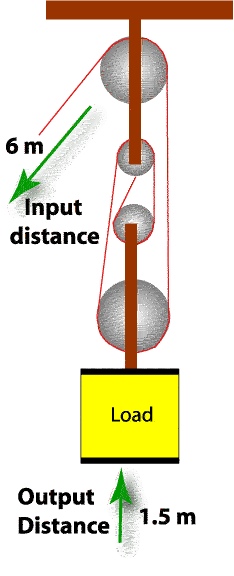 |

But what does this number mean?
In means that the input part of the pulley is moving four times faster than the output which is connected to the load. If we reflect back to the section on mechanical advantage you will see that it was 4 as well. Is there a connection between the two measurements?
4. Gears
Lesson 7
The wheel and axle is another example of a simple machine. You can think of it as a modified lever. There are a number of elements that can be added to an axle. It might hold a wheel or a pulley or a gear. In this lesson we are going to examine how gears work together to perform a task. As we talk about gears it would be very helpful to review the vocabulary of gears below.
 |
A gear is a wheel with regular teeth around its rim. |
 |
A gear train is composed of two or more gears that mesh together and allow a force to be transferred from on gear to the next.
|
 The small gear connected to the motor is the driving gear. |
The driving gear is the gear that supplies the driving force. It may be connected to a motor or a crank handle or some other power source.
|
In this case the large driven gear is meshing with the small driving gear  |
The driven gear is the gear wheel to which the force is applied.
|
 |
A set of reducing gears multiplies force but reduces the turning speed of the output axle. |
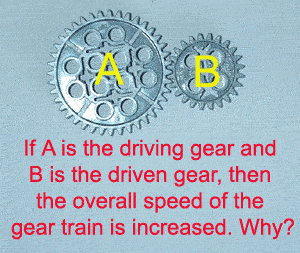 |
A set of multiplying gears is designed to increase the speed of the output axle, but in doing so it also reduces the twisting force of that axle.
|
 |
A gear ratio is the number of teeth of the driving gear to the number of teeth of the driven gear.
|
 |
In the reducing gear transmission on the left, the speed is reduced while the turning power of the three axles are progressively increased. The gear ratios in this transmission are: motor to first axle 8/40 1st axle / 2nd axle 8/40 2nd axle / 3rd axle 8/25 |
Calculating Speed Ratio
Using the examples of the multiplying gears and reducing gears above let's calculate the speed ratio of each.

So what do these calculations
really mean?
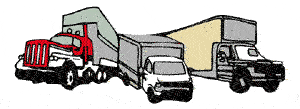 |
If we look at the first calculation it shows that multiplying gears produce a higher speed at the output of the transmission than goes in at the motor. The problem is that as the output speed goes up the the turning or twisting force is reduced. This is like trying to start a truck moving in fifth gear. As soon as the car's transmission is engaged the car's engine stalls out. There's just not enough engine power to turn the wheels against the pavement. |

If the gears in a machine don't directly mesh together but are connected by a chain, then the gears are called sprockets . The gears on bikes are called sprockets. You are going to be using sprockets in the next activity.
 |
|
© 2002 Alberta Online Consortium
|
6. Unit 4 Section 2 Quiz
You have two options for your Section 2 Quiz - a multiple choice quiz or a written response quiz. You may choose to write the multiple choice or the written response. You only need to write one, so the choice is up to you! You are allowed to try both quizzes if you want, but it is not required.
The quiz attempt with the highest grade will be the one that is recorded on your report card.
The multiple choice quiz has 10 multiple choice, matching, and true/false questions. You have 15 minutes to complete it. As soon as the quiz is submitted it will be auto-graded and you will receive a grade immediately.
Click the image above to start your quiz
The written response quiz has 5 short answer questions. Your responses must give a complete and detailed answer to the question. You have 20 minutes to complete the quiz. This quiz needs to be manually marked by your teacher, so you may have to wait a few days to get feedback and a grade.
Click the image above to start your quiz




